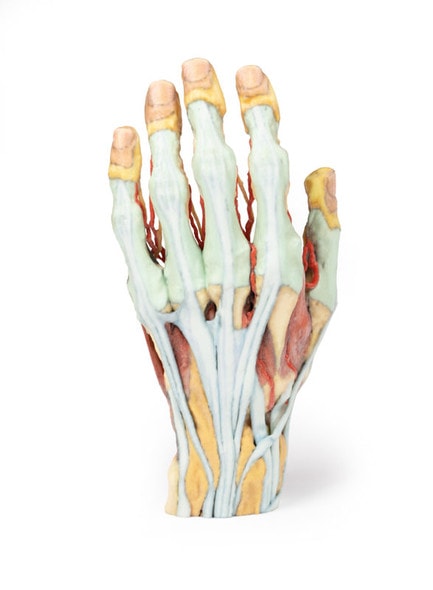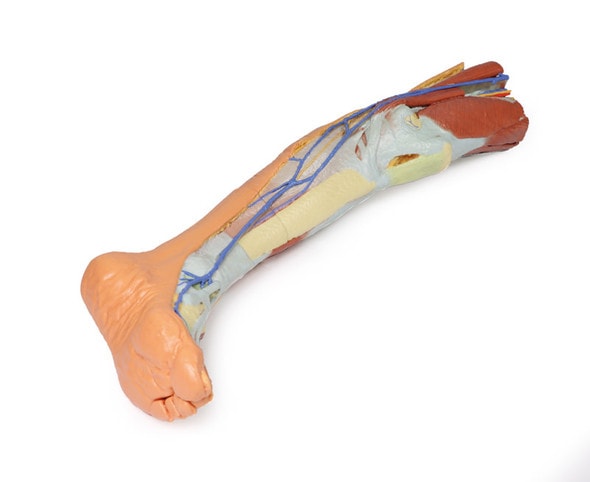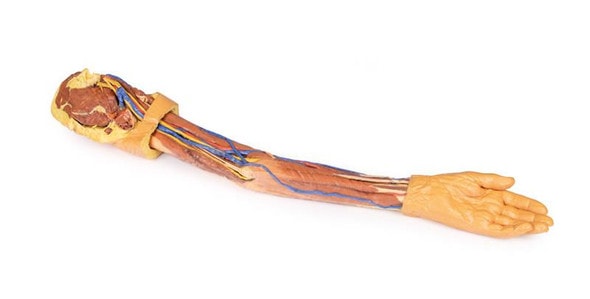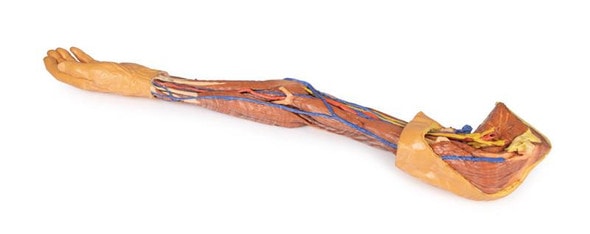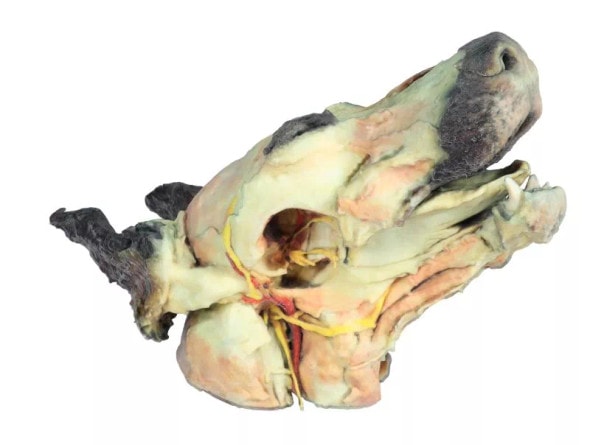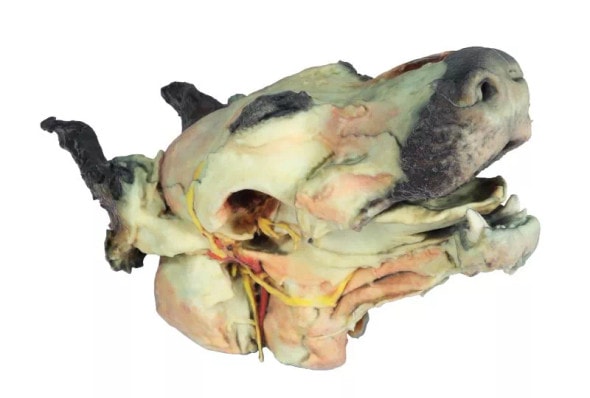Description
This 3D model presents a superficial dissection of a left face anterior to the ear with false coloring highlighting a series of neurovascular structures alongside the superficial muscles of facial expression. This compliments the more expanded superficial dissection of the face and lateral head presented in our HW 45 model. The undissected regions of the model have been digitally removed.
Starting just anterior to the ear, the opened window of dissection has exposed the parotid gland and associated duct transmitting anterior towards the oral cavity. Exiting from the margins of the parotid gland are terminal branches of the facial nerve (CN VII), including the cervical, mandibular, buccal, zygomatic and temporal. The cervical and mandibular branches at the inferior portion of the dissection window can be seen angling inferiorly and passing superficially relative to the facial vein (which ascends towards the medial canthus of the eye). The mandibular branch passes just deep to the facial artery, which runs in parallel with the facial vein. Tracing the pathway of these vessels from the mandible towards the nasal and orbital regions also provides a checklist of superficial and deep muscles that have been highlighted, from the masseter deep to the parotid through to the depressor anguli oris, depressor labii inferioris, the zygomaticus major and minor, the orbicularis oris, the nasalis and levator labii superioris alaeque, the procerus and the orbicularis oculi.
Along the superior margin of the parotid gland the base of the auriculotemporal nerve and the superficial temporal artery ascends anterior to the ear and rests on a partially dissected temporal fascia to expose part of the temporalis muscle. Moving anteriorly over the orbit, the supraorbital nerve and supraorbital and supratrochlear arteries have been highlighted and ascend on the epicranial aponeurosis. Within that layer the deeper frontalis muscle can be appreciated as a darker shadow within the layer.
Advantages of 3D Printed Anatomical Models
- 3D printed anatomical models are the most anatomically accurate examples of human anatomy because they are based on real human specimens.
- Avoid the ethical complications and complex handling, storage, and documentation requirements with 3D printed models when compared to human cadaveric specimens.
- 3D printed anatomy models are far less expensive than real human cadaveric specimens.
- Reproducibility and consistency allow for standardization of education and faster availability of models when you need them.
- Customization options are available for specific applications or educational needs. Enlargement, highlighting of specific anatomical structures, cutaway views, and more are just some of the customizations available.
Disadvantages of Human Cadavers
- Access to cadavers can be problematic and ethical complications are hard to avoid. Many countries cannot access cadavers for cultural and religious reasons.
- Human cadavers are costly to procure and require expensive storage facilities and dedicated staff to maintain them. Maintenance of the facility alone is costly.
- The cost to develop a cadaver lab or plastination technique is extremely high. Those funds could purchase hundreds of easy to handle, realistic 3D printed anatomical replicas.
- Wet specimens cannot be used in uncertified labs. Certification is expensive and time-consuming.
- Exposure to preservation fluids and chemicals is known to cause long-term health problems for lab workers and students. 3D printed anatomical replicas are safe to handle without any special equipment.
- Lack of reuse and reproducibility. If a dissection mistake is made, a new specimen has to be used and students have to start all over again.
Disadvantages of Plastinated Specimens
- Like real human cadaveric specimens, plastinated models are extremely expensive.
- Plastinated specimens still require real human samples and pose the same ethical issues as real human cadavers.
- The plastination process is extensive and takes months or longer to complete. 3D printed human anatomical models are available in a fraction of the time.
- Plastinated models, like human cadavers, are one of a kind and can only showcase one presentation of human anatomy.
Advanced 3D Printing Techniques for Superior Results
- Vibrant color offering with 10 million colors
- UV-curable inkjet printing
- High quality 3D printing that can create products that are delicate, extremely precise, and incredibly realistic
- To improve durability of fragile, thin, and delicate arteries, veins or vessels, a clear support material is printed in key areas. This makes the models robust so they can be handled by students easily.




















